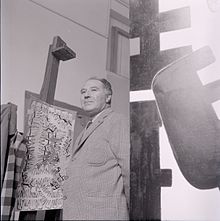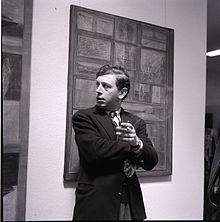Spatialism
- Machine translation, like DeepL or Google Translate, is a useful starting point for translations, but translators must revise errors as necessary and confirm that the translation is accurate, rather than simply copy-pasting machine-translated text into the English Wikipedia.
- Consider adding a topic to this template: there are already 3,024 articles in the main category, and specifying
|topic=will aid in categorization. - Do not translate text that appears unreliable or low-quality. If possible, verify the text with references provided in the foreign-language article.
- You must provide copyright attribution in the edit summary accompanying your translation by providing an interlanguage link to the source of your translation. A model attribution edit summary is
Content in this edit is translated from the existing Italian Wikipedia article at [[:it:Movimento spazialista]]; see its history for attribution. - You may also add the template
{{Translated|it|Movimento spazialista}}to the talk page. - For more guidance, see Wikipedia:Translation.

Spatialism (Italian: Spazialismo) is an art movement founded by Argentine-Italian artist Lucio Fontana[1] in Milan in 1947 in which he proposed to synthesize colour, sound, space, movement, and time into a new type of art.
Overview
The main ideas of the movement were anticipated in his Manifiesto blanco (White Manifesto) published in Buenos Aires in 1946. In it he spoke of a new "spatial" art in keeping with the spirit of the post-war age. It repudiated the illusory or "virtual" space of traditional easel painting and sought to unite art and science to project colour and form into real space by the use of up-to-date techniques such as neon lighting and television. Five more manifestos followed; they were more specific in their negative than their positive aspects, and carried the concept of Spatialism little further than the statement that its essence consisted in "plastic emotions and emotions of colour projected upon space". In 1947 Fontana created a "Black Spatial Environment", a room painted black, which was considered to have foreshadowed Environment art. His stabbed and slashed canvases (beginning in 1949 and 1959 respectively) are also considered to embody Spatialism. An example of the slashed type (the slash made with a razor blade) is Spatial Concept Waiting (1960, Tate, London). Although Fontana's ideas were vague, his outlook was influential, for he was one of the first, certainly the first Latin American and European artist to truly promote the idea of art as gesture or performance, rather than as the creation of an enduring physical work.


Cyber-Spatialism
In 2005, the Franco-German artist couple Cécile Colle and Ralf Nuhn[2] produced a series of canvases with computer connectors inserted into them, entitled "Cyber-Spatialism." The project was heavily influenced by Fontana's work. According to the artists, "by substituting Fontana's slashes with computer connectors, Cyber-Spatialism implies an extension of the canvas into cyberspace, and thus attempts to address the notion, that in today's (globalized) culture, real space is increasingly being replaced by virtual space."[3]
Citations
References
- Chilvers, Ian. The concise Oxford dictionary of art and artists. Oxford University Press, 2003. Web. 13 October 2011.
External links
 Media related to Spatialism at Wikimedia Commons
Media related to Spatialism at Wikimedia Commons










